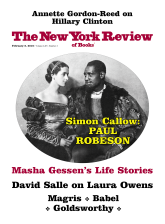In response to:
Super Goethe from the December 21, 2017 issue
To the Editors:
In his review of Rüdiger Safranski’s Goethe: Life as a Work of Art [“Super Goethe,” NYR, December 21, 2017], Ferdinand Mount concludes:
When [Goethe] finally made his long-dreamed-of trip to Italy, he remained impervious to the Christian art he saw. He was disappointed even by the classical monuments he saw in Rome, most of them at this date overgrown tumbles of stone. For all his endless fertility, Goethe’s imagination or lack of it has a forbidding quality. He made an exception for Mantegna’s frescoes in the Eremitani Chapel in Padua, which seemed to have a blunt, pure presence. “Presence” is the key word here. He condemned what he saw as the poverty of Christian mythology, always longing for something absent, dwelling, in a way that he regarded as unholy, on deprivation, suffering, and expectation rather than empowerment and possession. The only true divinity was Nature.
Goethe’s own impressions, as recorded in his Italian Journey (1786–1788), lead this reader to a wholly contrary assessment. His entry of October 17, 1786, from Cento, reveals he “liked very much one painting of [Guercino] which represents the risen Christ appearing to his mother.” An engraving after the painting shows the Christ child “in the foreground facing us, while the Madonna behind him is lifting his arm so that he may bless us with his raised fingers. A happy idea, and very much in the spirit of the Catholic [cf. ‘Christian’] mythology.” In Rome, finally, for the first time, he notes on November 1, 1786:
Now, at last, I have arrived in the First City of the world! Had I seen it fifteen years ago with an intelligent man to guide me, I should have called myself lucky, but, since I was destined to visit it alone and trust to my own eyes, I am happy, at least, to have been granted this joy so late in life.
Still further on that same day, he records:
All the dreams of my youth have come to life; the first engravings I remember—my father hung views of Rome in the hall—I now see in reality, and everything I have known for so long through paintings, drawings, etchings, woodcuts, plaster casts and cork models is now assembled before me.
And on November 3, 1786:
I looked at the frescoes and found some excellent ones by artists whose names I hardly knew—Carlo Maratti, for example, whom I soon came to love and admire. But it was the masterpieces of the artists whose style I had already studied which gave me the keenest pleasure. I saw a St. Petronilla by Guercino…. The body of the dead saint is lifted out of the tomb, restored to life and received into Heaven by a divine youth. Whatever objections there may be to this twofold action, the painting is beyond price.
His perception of the divinity of nature notwithstanding, Goethe’s reaction on viewing Christian-themed art in so many forms was anything but impervious.
Adam Jacobs
Wayne, New Jersey
Ferdinand Mount replies:
Certainly Goethe is now and then charmed by the pictures and frescoes he sees in Italy, and he is often impressed by the painterly technique of the artists in question. He is touched by pretty madonnas and chubby babies, but he remains indifferent, sometimes openly hostile, to the Christian message behind them. He detests in particular martyrdoms and crucifixions, in fact any graphic image of suffering. In between the passages quoted by Mr. Jacobs, he writes of the Carracci family, Guido Reni, and Domenichino:
The main obstacle to understanding these painters is their absurd subjects, which drive me mad, though I would like to admire and love them.
It is as if the sons of gods had married the daughters of men and begotten of them a variety of monsters. It is always the same, even with a genius like Guido. You find yourself in the dissecting room, at the foot of the gallows, on the edge of the corpse pit. His heroes always suffer and never act. Never an interest in everyday life, always the expectation of something fantastic about to appear from outside…. Out of ten subjects, only one should have been painted and even that one the artist was not allowed to paint from the proper angle.
The large picture by Guido in the Church of the Mendicanti [the famous Pietà dei Mendicanti, now in the Bologna Pinacoteca] is, technically, everything that a painting should be, but the subject is the ultimate in absurdities which can be forced upon an artist….
When I look at history in this black mood, I feel inclined to say: first faith ennobled the arts, then superstition took over and ruined them (October 19, 1786).
Goethe’s Italian Journey is largely made up of agreeable traveler’s impressions of the sort that any sensitive Grand Tourist, of his day or ours, might have put together. What seem to me uniquely and memorably Goethean are the passages where he breaks out in passionate revulsion against Christian liturgy and iconography.
This Issue
February 8, 2018
To Be, or Not to Be
Female Trouble
The Emperor Robeson



